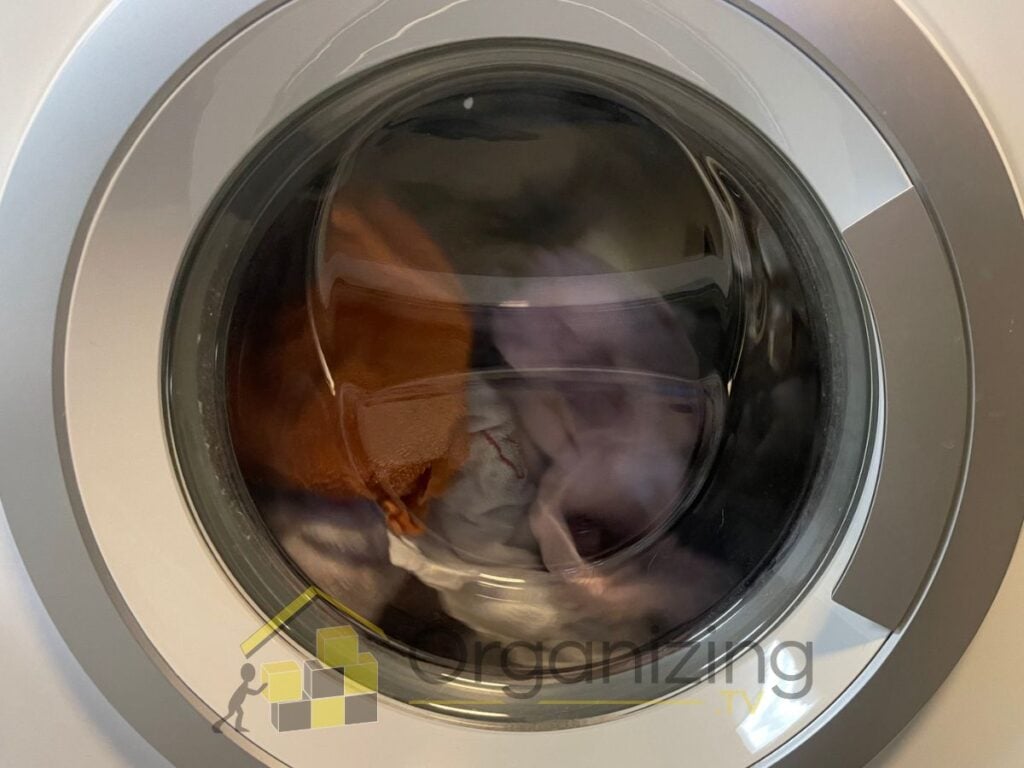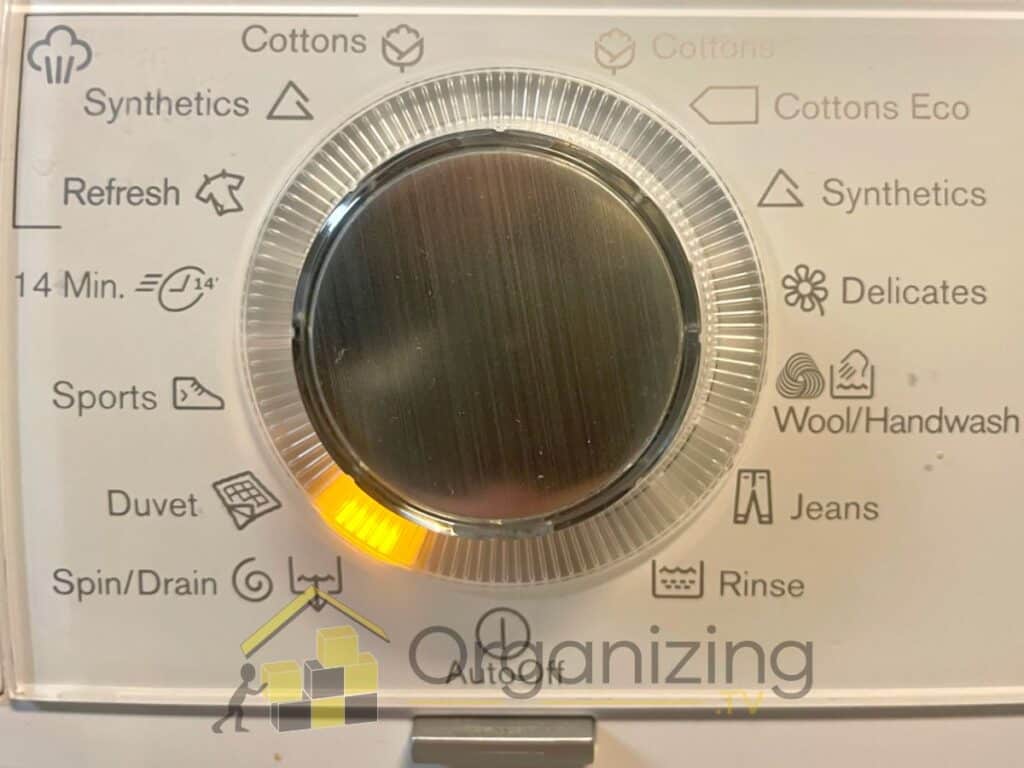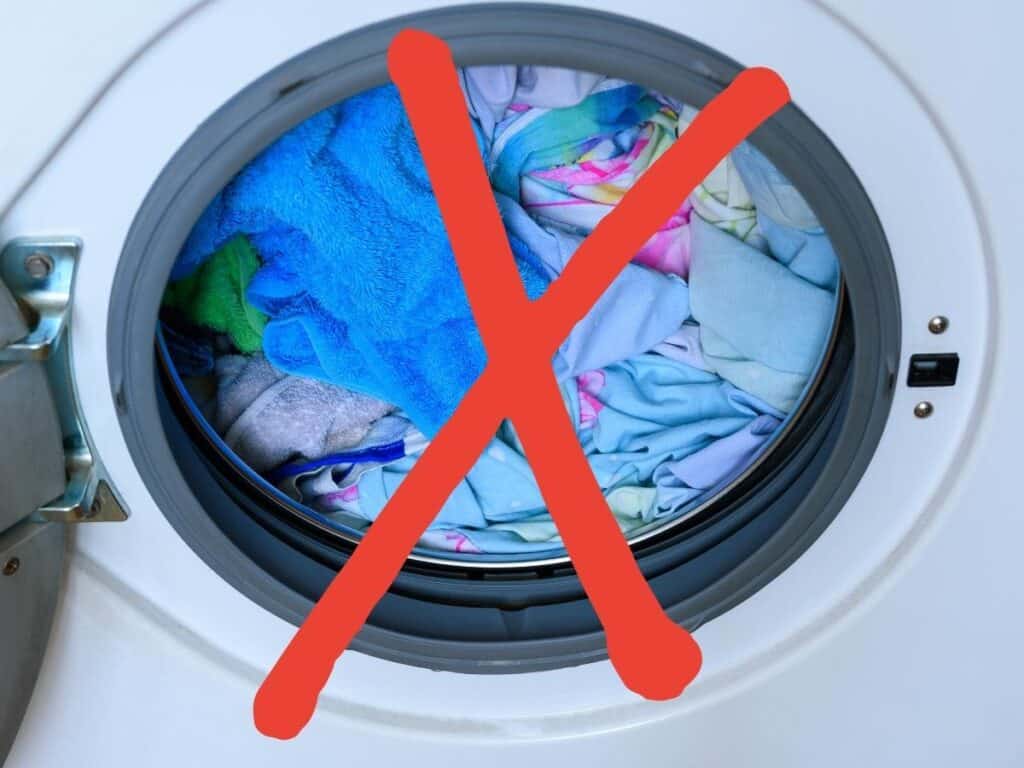Modern washing machines are loaded with functions that have made choosing the right machine a little complicated. Besides considering front or top load, capacity, and stackability, you must also identify critical functions, such as air drying, in washing machines, and their benefits.
The air dry in the washing machine is a function where vents within the drum run warm air over wet clothes during the spin cycle. As the drum rotates, it wrings excess water from the clothes. Meanwhile, the vents draw warm air from the surroundings and dry the clothes without heat.
In this article, I’ll discuss the air drying feature in washing machines in detail, why you should use it, and how to get the most out of it.
What the Air Dry Setting Does
The air dry setting is one of the features added to recent washing machine models. It uses an air current to dry clothes and is usually used after the spin cycle. Washing machines with the air dry setting have vents that open and allow air into the washing machine.
As the drum spins, the air circulates and dries the clothes. However, this setting is ineffective on wet clothes. It reduces the drying time when you move the clothes to the dryer or clothesline.
How To Use Air Dry in the Washing Machine

The air dry feature in washing machines will leave your clothes over 90% dry. Most automatic washing machine brands have the air dry setting, which comes at the end of the spin cycle. However, each brand has a different approach to getting to the air dry setting.
Wash your clothes as you normally do until you complete the spin cycle. After this, you can go to the air dry setting, depending on the brand of your washing machine. Some brands use different terms when referring to air drying in their washer. For example, Samsung uses the term air turbo drying.
| Washing Machine Brand | How To Use The Air Dry Function. |
| Samsung | After the spin cycle, press the air turbo button. The air turbo button will only work when the spin cycle is still on. Press the button repeatedly to set the time (15 min, 30 min, and off). |
| Electrolux | Use half load if you wish to go through the entire wash cycle, including the air dry setting. Press the power button at the center of the control dial. Take your wash through the normal cycle. After the spin cycle, turn the knob to drying cotton or drying mixed, depending on the fabrics in the washer. You can also press the manual dryer and set the time for air drying. |
| GE | Add a small load (2–3kg/4.4lb–6.6 lbs) to the washer.Select your wash cycle.Press 1 step wash & dry.After the wash, the washer automatically tumbles the clothes dry.The air dry cycle is set for 8 hours, but you can remove the clothes at any point and hang them to dry. |
| Panasonic | Air dry comes after the spin cycle. The load limit is 3kg/6.6 lbs.Start the washer.Press the air dry button repeatedly to set the time. Press the start/pause button. |
| LG | Go through the normal wash process until the spin cycle. Ensure the clothes are damp. The air drying cycle will not be effective on very wet clothes. Load about 2kg (4.4 lbs) of damp clothes in the washing machine. Hold the spin button for 3 seconds and select air dry. The duration is automatically set to 60 minutes, but you can press the spin button to change the time to 90 or 120 minutes. Press the start button to start the air-drying process. Press the power button when you want to end the cycle earlier. |
| Hisense | Power your washing machine.After the wash and spin cycle, press the temp button repeatedly until you get to the air dry option.Set up the settings according to the fabric.The washer will automatically adjust the drying time depending on the load. |
| Whirlpool | Go through the normal washing cycle.Press the Wash & Dry button (3 seconds) for it to change to Fan Fresh. Fan Fresh setting is designed for overnight drying unless you air dry a small load. |
The processes above work with some washing machine models. You’ll need to check the user manual to confirm how to use the air dry function in your washing machine model.
If you’re more of a visual learner, check out this helpful YouTube video on how to use the air dry mode in a GE washing machine:
Air Dry vs. Spin Dry
Since they perform a similar function, it’s easy to assume that air dry and spin dry are the same. Both speed up the drying process by removing excess moisture from the clothes before taking them to the clothesline or ironing them. However, these are different processes in the washing machine.
Older washing machine models tend to have the spin dry feature but not the air-dry setting. On the other hand, newer models have both the air dry and spin dry functions.
Air Dry
The air drying function uses air current through the vents at the door or top of the washer to dry the clothes. When you press the air dry button or alternative buttons, depending on the brand, the tiny holes open and allow warm air from the surrounding area into the washing machine.
As the drum spins, the air circulates and dries the clothes. It’s best to point out that the air drying setting is ineffective on very wet clothes since it doesn’t use heat. Therefore, it’s best to run them through the spin cycle before air drying them.
Spin Dry

When using a washing machine with the spin dry setting, the vents remain closed. The drum spins rapidly, so the clothes lose the excess moisture. Washing machines have different spin speeds, affecting how quickly your clothes lose moisture.
If two washing machines with different speeds are set to spin for 10 minutes, the one with a higher rpm (revolutions per minute) spins and dries clothes faster.
Despite the obvious differences in how the spin dry and air dry functions work, there are some similarities:
- Both methods don’t use heat.
- Clothes don’t usually dry completely. However, clothes subjected to the air drying function are relatively drier than those you only spin dry.
Air-dried clothes are sometimes over 90% dry when you get them out of the washer. Some fabrics retain more moisture, leaving them at least 40% dry. You’ll still need to hang them to dry or iron them. When you only spin dry your clothes, ironing them may not work because they’re still quite damp. You’ll either need to move them to a dryer or the clothesline.
| Air Dry | Spin Dry |
| Clothes take longer to lose moisture (usually an hour or longer). | Spin drying takes a short time. |
| The clothes aren’t so damp. | Clothes are damper than when air dried. |
| The clothes dry using air circulation. | Excess water is removed using centrifugal force. |
| 3kg/6lb maximum weight for better air circulation. | Maximum weight of the washing machine, so you spin more clothes. |
Is Machine Air Dry Better Than Spin Dry?
When using either the air dry or spin dry feature, you need to understand why and when to use them. Both features have their benefits, and sometimes it’s best to use one setting over the other.
Machine air dry is typically better than spin drying because the clothes dry better and have fewer wrinkles while using less energy. Additionally, air-drying limits wear and tear, shrinkage, and mold growth. However, air drying takes longer than spin-drying and is ineffective on wet clothes.
The air dry and spin dry features of washing machines have advantages and disadvantages. The decision on which one to use will depend on how quickly you wish the clothes to dry and their condition after the washing cycle.
Why Air Drying in the Washing Machine Takes a Long Time
The average drying cycle in the dryer is 45 minutes. The air drying feature in washing machines takes a minimum of an hour for a small load with clothes made of fabric that dries quickly, such as polyester and nylon.
Some washing machines have specific timings for air drying, with some set to last hours. For example, Whirlpool uses the Fan fresh feature, with the recommendation to run it overnight unless the load is small.
The air drying feature takes a long time to dry clothes because no heat is involved. Washing machine models with this feature have vents at the door for front loaders and at the lid for top loaders.
When you press the air dry mode, the vents open, and air from the surrounding area circulates in the washer and dries the clothes. Since the air isn’t hot, it takes some time for the clothes to dry.
You shouldn’t air dry very wet clothes because they’ll remain wet for too long, encouraging mold and bacteria to grow.
The duration you run your washing machine in air dry mode will depend on the following:
- The fabric. Some clothes dry faster, so you can set the air dry function to a shorter time. For example, polyester, acrylic, and nylon will dry in an hour or two.
- The load. Most washers recommend a smaller load for air drying, usually 2–3kg (4.4–6.6 lbs). This allows air to circulate properly and dry the clothes faster. Check out my article about washing machine load sizes, where I detail how to estimate load sizes when adding clothes to the washer.
- The fabric’s thickness. Clothes with a thick weave take longer to air dry than those with a thin weave.
Benefits of Air Drying in the Washing Machine
Few people have the space or resources for a dryer, so a washing machine with air dry is a compromise. The air drying function doesn’t dry clothes to the level that dryers do, but it dries them enough for ironing.
There are several benefits of air drying in washing machines:
- It reduces drying time, especially if you hang your clothes outside. If you use a dryer, you’ll also run your clothes through the cycle for a shorter time after air drying them.
- It conserves energy.
- The air drying process is more gentle on fabric since it doesn’t use heat. Some fabrics, such as cotton, tear easily when repeatedly exposed to high temperatures in the dryer.
- Clothes that are air-dried in the washing machine don’t shrink.
- It’s a solution for fabrics that shouldn’t be exposed to heat when drying.
- As the clothes spin during the air dry cycle, they lose the excess moisture and subsequently reduce static cling in clothes.
- Clothes taken through the air dry cycle have significantly fewer wrinkles than those that go through the spin dry cycle.
- The air circulating through the clothes helps to remove pet hair from the clothes.
- It reduces drying time, especially if you don’t have a dryer and the weather isn’t favorable for drying clothes.
- It prevents stiffness in clothes resulting from moisture “gluing” fibers together.
Challenges of Air Drying in the Washing Machine
The air drying feature has so much going for it. It adds time to your washing cycle but reduces the drying time, whether you’re doing it outdoors or in the dryer. However, the air drying feature has its challenges.
Clothes tend to have wrinkles since the process doesn’t use heat, as with the dryer. Unlike spin-drying, the air circulating in the washing machine and between the clothes prevents excessive wrinkles. However, the wrinkles are more pronounced than in clothes dried in the dryer.
Mistakes To Avoid When Using the Air Dry Function
It’s not surprising that most washing machine brands include the air dry feature and make it a selling point for their washing machines — it’s handy and has many benefits. However, you should avoid making the following mistake when using the air drying feature in washing machines:
- Don’t air dry clothes with lace because it will fray as the drum spins.
- Remove the clothes immediately after the air dry cycle, hang them outside, iron them, or put them in the dryer. Leaving them in the washer will cause mold to grow because they don’t dry completely.
- Don’t overload or load the washing machine to capacity. It’ll take longer for the clothes to dry.

Your washing machine’s user manual is the best guide for using the air drying function. Follow the instructions, and you won’t have any issues with the process or your clothes.
Conclusion
All electronics have key features manufacturers consider crucial for consumers to know from the get-go. In washing machines, an air dry mode is significant. This is why you’ll find some washers with air dry stickers visible from afar.
Older washing machine models have the spin cycle as the last step. In contrast, newer ones have the air dry mode as an optional final step, especially if you want to save your clothes from the long-term effects of heat damage. However, you need to use it correctly to reap the benefits.
If you want to learn more about your washing machine’s settings, check out this article.


I’m an expert wardrobe organizer and a bit of a clean freak. I created this website and its YouTube channel to share practical guides about laundry and organizing. My teachings have been featured in multiple large news publications, and I’ve self-published two wardrobe organizing books and an entire course on the subject.

